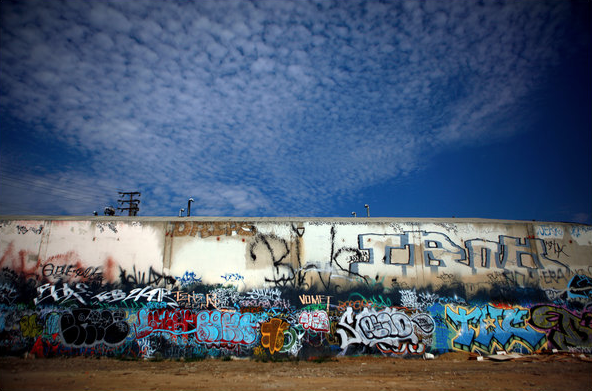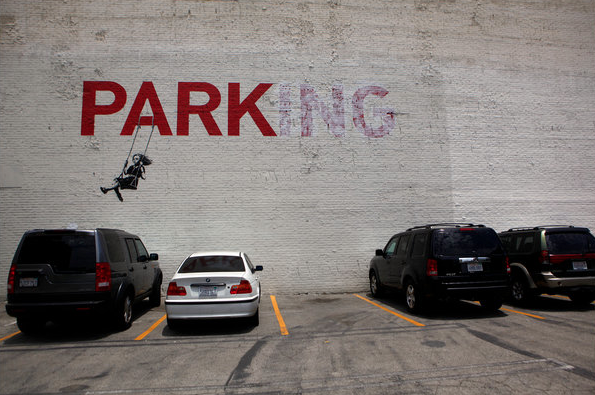Notes
What's Really Ruining America: Graffiti!
I didn’t start out looking for graffiti. I had bigger fish to fry: the bad economy getting worse, and outright catastrophe looming as the GOP prepares to wreck the county rather than anger Grover Norquist. I can’t just write about national problems, however: there has to be a photograph.
Whether seen as documentary record or public artwork, the image provides writer and reader alike with a basis for thinking about things held in common. But look around, from the print editions to the slide shows, and you would hardly know that the economy exists, much less that people might be out of work, underemployed, working harder for less, or otherwise worried about the future. And maybe that’s why the New York Times decided to write about an upsurge in graffiti.
Yes, it’s true: graffiti is on the rise. This image from LA captures the mood of the article: an empty, urban wasteland degraded further by anonymous vandalism, while all we should be seeing are blue skies. Now the Times can write about whatever they want, but this story is worrisome for a number of reasons. One is that it is frivolous, and the times are not. Would that the paper of record had instead zeroed in on why kids all over the country are more than usually keen on tagging property.
Another problem is that the story repeats a very tired meme that the Times has been pushing for decades, which is that graffiti always is a sign of urban decay; this despite its development as a vernacular art that can just as easily improve a community as harm it. Imagine if both porn and ballet were labeled “soft-core,” or if all risk taking from the casinos to Wall street were labeled “gambling.” In each case the label would be true, but something would be lost in translation. Graffiti can be a serious blight, but the examples in the Times own slide show indicate that there is more to the story.
My biggest gripe is with the way that the story attempts to present a balanced account. In what may appear to be sophisticated coverage, the Times reports that “The upturn has prompted concern among city officials and renewed a debate about whether glorifying such displays–be it in museum exhibits, tattoos, or television advertisements–contributes to urban blight and economic decay.” And there, in a stroke, we have it: The Times channeling Fox News. The leading explanation faults culture, not economics or politics, and suggests that a culture war is underway and the rightful center of public debate, and that the real danger comes from curators and other liberals who promote transgression in the arts and refuse to stand up to media corruption–no doubt because they are relativists rather than values voters.
Of course, in the next line the Times provides the far more plausible explanation: “But it is also stirring a debate about what is causing this recent surge and whether it might be an early indicator that anxiety and alienation are growing in some struggling urban areas in the face of stubborn unemployment and the lingering effects of the recession.” Oh, ya think? In fact, even the best uses of graffiti are likely to be on the rise for the same reason, as neighborhoods pull together around the arts when nothing more substantial is forthcoming from their leaders.
The pairing of two explanations–one where culture harms the economy, and the other where the economy affects culture–is not journalistic objectivity; no, it’s a false equivalence, and one that encourages the reader to believe that the state should be treating symptoms rather than causes. The Times is schooling its readers in the same habits of delusion and denial that are at the core of the national decline. One can easily imagine the likely response: more cops, not more jobs and summer programs. More gated communities instead of more public investment. More starving of the cities by state legislatures, rather than raising taxes to nurture economic development.
And the truth gets left in the gutter. Graffiti can be a sign of decay, and cities large and small, like the suburbs and rural areas around them, are struggling with very serious problems. Most of those problems have been created by men in suits, however, not by artists in tennis shoes.
— Robert Hariman
(Cross-posted from No Caption Needed)
(Photos: Eric Thayer for the New York Times)




Reactions
Comments Powered by Disqus